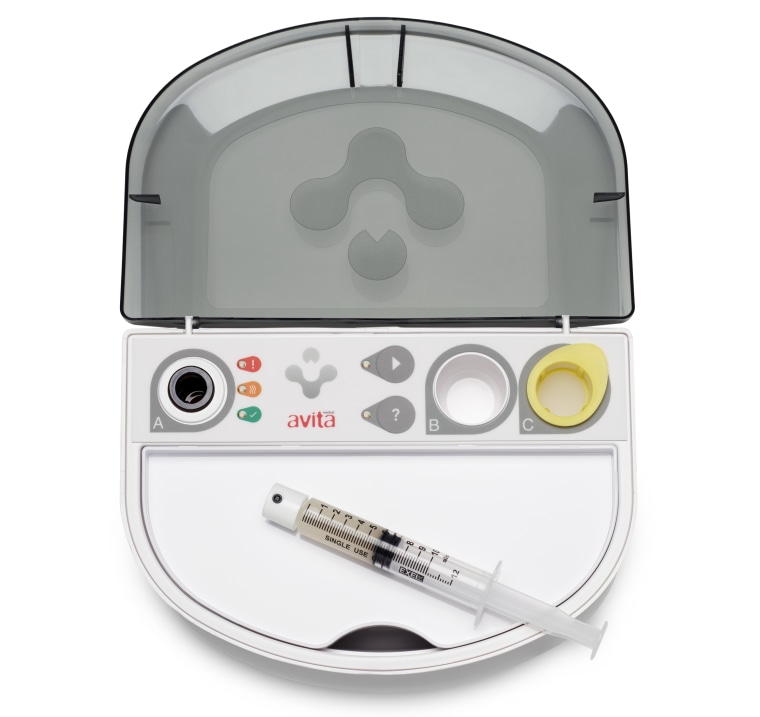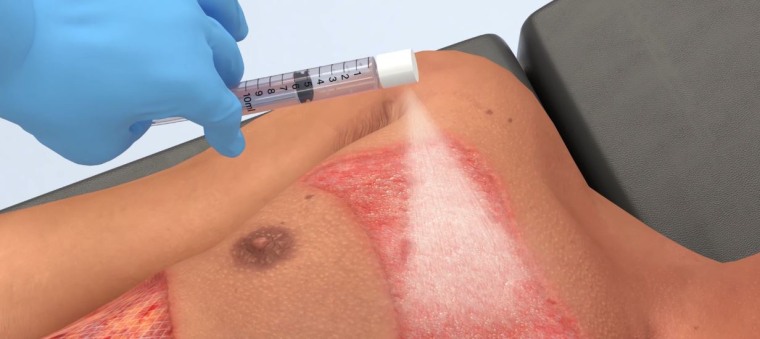Dylan Melancon estimates that he was going 70 miles an hour when he crashed his motorcycle on a hot New Orleans highway this past June.
He wasn’t wearing leathers or other protective clothing. Melancon's virtually unprotected body slid along the concrete at high speed for yards. “I was wearing dress pants and a T-shirt. Afterwards, I was wearing no pants,” the 26-year-old nursing student said.
Melancon had deep burns and abrasions on his knees, elbows, thighs, stomach and back. They were the kind of injuries that usually put people into the hospital for months of painful skin grafts.
Melancon’s doctor instead got permission to treat him with ReCell, a spray-on skin product designed to treat burns with a slurry of the patient’s own skin cells.

“You just spray it on the patient, on the burned area,” said Chris Houchens of the federal government’s Biomedical Advanced Research and Development Authority, or BARDA, which helped pay for its development. The cells in the solution take hold and start to grow, forming a fresh layer of normal skin.
It was experimental then, but the Food and Drug Administration approved ReCell Thursday night. Avita Medical, a small regenerative medicine company, will develop the product for sale in the United States.
It’s the first spray-on skin product to win approval for the U.S. market.
Close to half a million people get burns so bad that they need medical treatment, according to the American Burn Association and the Centers for Disease Control and Prevention.
The current standard of care for serious burns is a skin graft. But skin grafts mean cutting away healthy skin to lay over the burns, which results in even more skin to heal. Plus, it’s painful.
“When they took the skin for the grafts, it burned like fire,” said Melancon, who lives in New Orleans. Patients often end up with disfiguring scars both on the burned area and on the skin where the graft was taken from.
Scientists have been working for more than a decade to come up with something better. Spray-on skin is one obvious-sounding solution: take a small skin sample, turn it into a solution, and coat the burnt area with a thin layer of skin cells that can grow back and cover the wound.
Teams are working on 3-D skin printers, spray guns and other technologies to do this. A rival to Avita, RenovaCare, is working on a system called SkinGun that sprays a similar mist of cells onto a wound.
Avita won the race for FDA approval with its ReCell system. To get FDA approval, companies must come up with a unique technology and then show that it works at least as well as, if not better than, the current treatments.
Avita’s system uses a unique combination of enzymes to break down the layers of skin from a piece of tissue, then mix them into a liquid that can be applied to the skin using a low-tech spray syringe.
The ReCell system considerably reduces how much skin must be removed to lay over the burnt surface, said Avita Medical CEO Dr. Mike Perry.

For a standard skin graft, surgeons usually must remove an area of healthy skin no smaller than three-quarters of the size of the wound, then stretch it over the damaged area. “So if a person has burns covering 10 percent of their body, the area of the skin graft that would be required is about equal to a grown adult’s full back,” Perry said.
“You are creating new wounds when you take those skin samples to cover the burn.”
The most serious burns often cause little pain, because the nerves are destroyed along with skin and muscle tissue. But the grafts use the top layers of skin, right where the most nerves are. “These patients are in extraordinary pain,” Perry said. “Taking those skin grafts is just excruciating.”
The ReCell system considerably reduces the amount of healthy skin that must be removed — by 97 percent for a second-degree burn, Perry said.
“If your whole back was burned, all you would need is a piece of skin the size of a credit card to replace that damage,” Houchens said.
The burns heal more quickly and patients end up spending less time in the hospital, he said. Two clinical trials showed quicker recovery using less skin than standard grafts.
It takes about 30 minutes to process a skin sample from a patient, Perry said. Because the cells come from the patient, there is no risk of rejection.

Melancon was very happy with his results. “Overall, I believe it was 34 percent of my body that was burned,” he said. That would normally mean two months or more in the hospital for recovery, with much of that time spent taking narcotics for the pain.
Melancon spent just 3 ½ weeks in the hospital after his June 26 accident. He said he stopped taking pain medication by mid-August so he could start back in his nursing school classes.
“On my knees I had burned essentially down to just bone,” he said. He also lost skin off the areas from which skin grafts are usually harvested: the back, abdominal area and his thighs. “The doctor didn’t have much skin to work with,” Melancon said.
Now, he says, he has very little pain. “I show everyone my grafts and scarring and everyone is surprised at how well it works,” he said. Hair follicles have started growing back in some areas, and in some, he said, scars are barely visible.
“I’m proof that it works,” Melancon said.
Perry said Avita has not settled on a price for the ReCell system, but it will most likely be between $5,000 and $10,000 per unit, which can treat about 10 percent of a patient’s body surface area. Someone with burns over 50 percent of the body would require five units for treatment — more for deeper burns.
BARDA will buy some of the kits for the national stockpile of medicines and equipment on standby for big emergencies such as major explosions and chemical or nuclear attacks.
“If you think of a mass casualty event, we don’t have enough beds to be able to treat hundreds of patients at a time,” Houchens told NBC News.
“We don’t have enough burn specialists. Our system will be completely overwhelmed. Having this technology that allows us to treat this in 30 minutes is really transformational.”
BARDA and other federal agencies have been trying to support and encourage researchers to make spray-on skin for years. The agency invested about $50 million in the development of ReCell.
“These products are mostly going to be used by hospitals and by physicians to treat patients who are injured in a house fire or a gas explosion or a car accident,” Houchens said. But, he said, when a company can commercially develop a government-supported product, it should get wider use, which can bring the price down.


